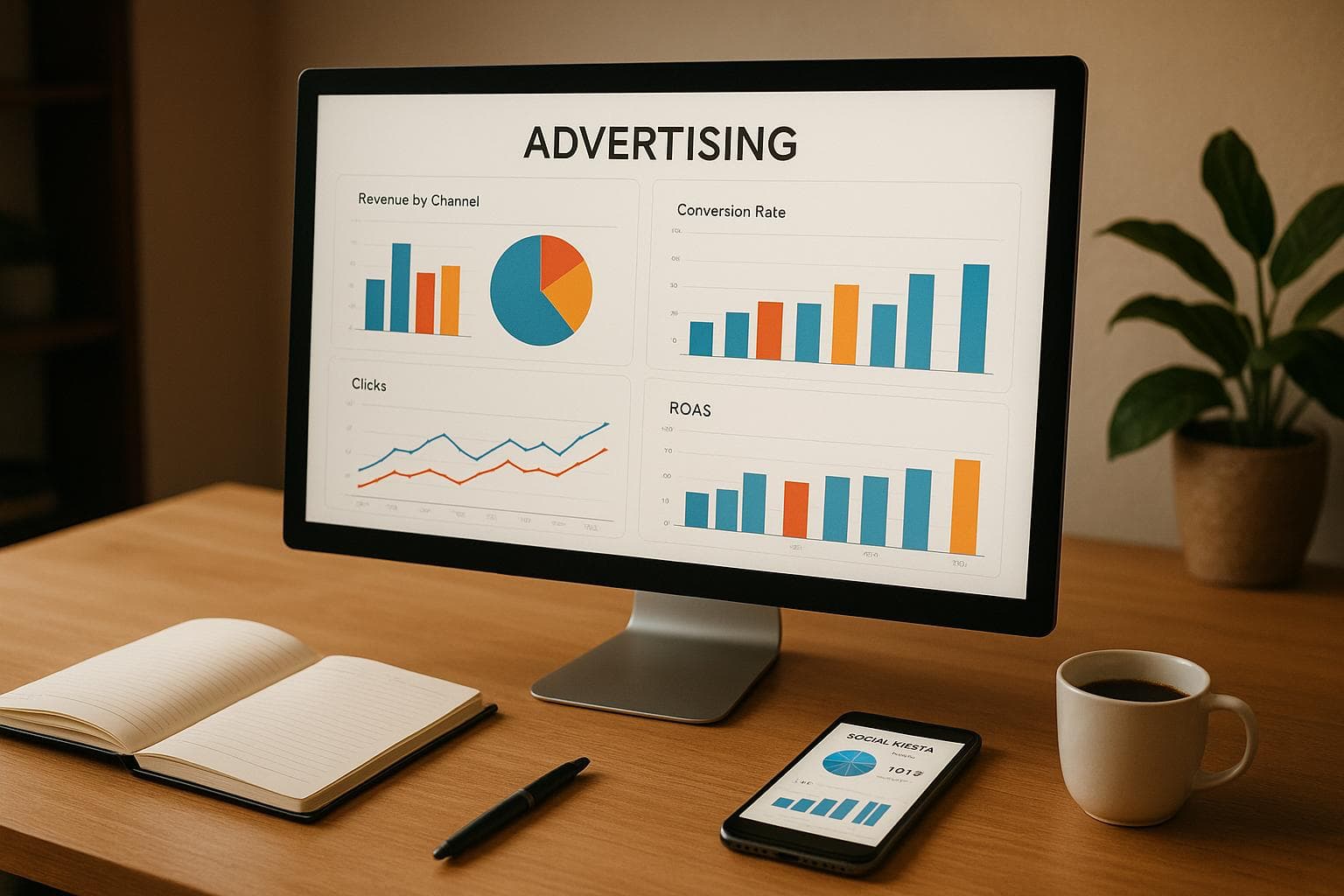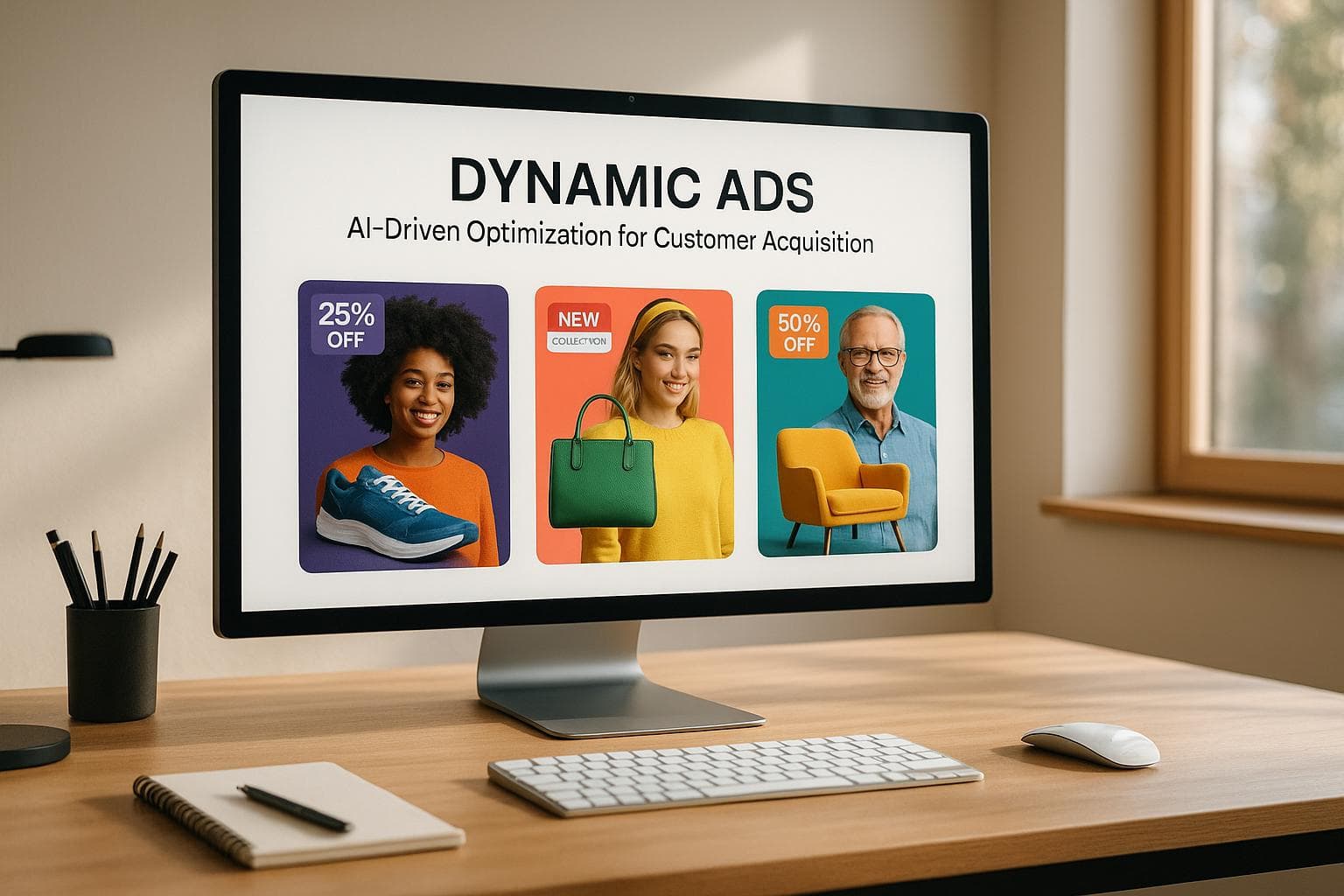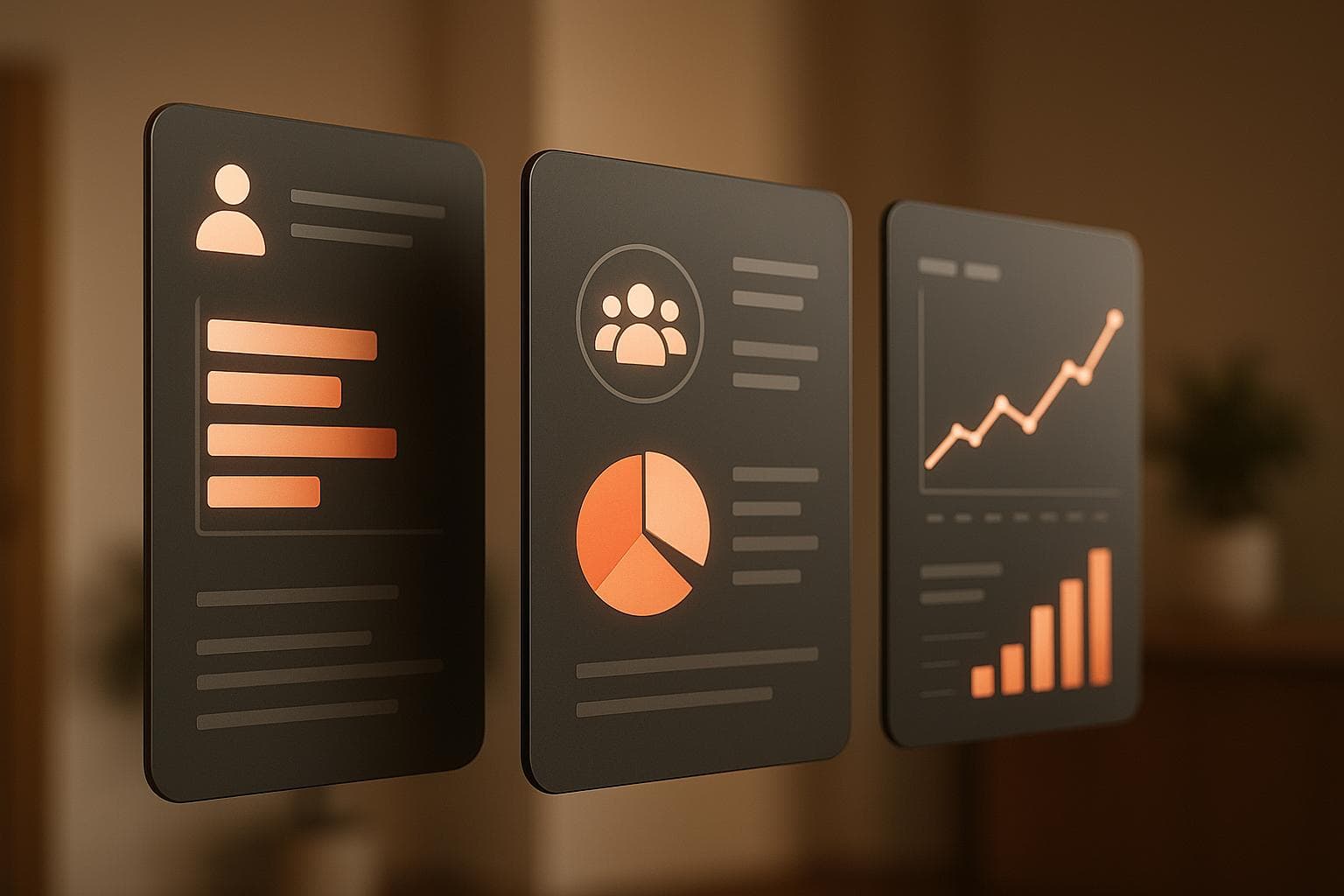How to Customize KPIs for Multi-Channel Ads
Learn how to effectively customize KPIs for multi-channel advertising across platforms like Google, Meta, and Microsoft Ads for better performance tracking.
Running ads across platforms like Google, Meta (Facebook and Instagram), and Microsoft Ads can feel overwhelming due to the sheer volume of data and varying metrics each platform uses. Here's the key takeaway: customizing KPIs for each platform while maintaining a unified tracking system is essential for effective multi-channel advertising.
Key Points:
- Set clear goals: Define whether your campaign aims for brand awareness, lead generation, or direct sales. Use specific, measurable objectives (e.g., "Increase sales by 20% in 3 months").
- Choose platform-specific KPIs:
- Google Ads: Focus on conversion rate, ROAS, and quality score.
- Meta Ads: Track engagement rate, impressions, and CPA.
- Microsoft Ads: Look at CTR, impression share, and cost per lead.
- Use attribution models wisely: Align KPIs with your chosen model (e.g., first-click, last-click, or multi-touch) to understand each platform's role in the customer journey.
- Leverage benchmarks and past data: Compare performance against industry standards and your historical metrics to set realistic targets.
- Centralize tracking and automate reports: Tools like Feedcast.ai consolidate data from all platforms, saving time and reducing manual errors.
- Use AI for optimization: AI-driven tools analyze performance, provide actionable recommendations, and help adjust strategies in real time.
By aligning KPIs with platform strengths and using centralized tools, you can better allocate budgets, measure performance, and achieve your marketing goals.
Setting Campaign Goals and Matching KPIs
Defining Campaign Goals
Clear and specific campaign goals are the foundation of an effective strategy and budget. Most campaigns focus on one of three main objectives: brand awareness, lead generation, or direct sales. Each of these requires its own approach and specific metrics to measure success.
Different platforms bring unique strengths to the table. For instance, Google Ads is ideal for capturing users with high purchase intent, Meta Platforms are great for discovery and engagement, and Microsoft Ads cater to niche audiences.
A helpful way to define your goals is by using the SMART framework. Instead of broad targets like "increase sales", set measurable objectives such as: "Increase online sales by 20% within three months using Google and Meta campaigns." This kind of goal not only clarifies your direction but also simplifies the process of selecting KPIs and tracking progress.
Take, for example, an e-commerce brand launching a new product line. A specific goal might be to achieve 500 sales within the first month. This target is clear, measurable, and time-bound, offering a solid foundation for planning and evaluation.
Choosing the Right KPIs for Your Goals
Each campaign goal aligns with specific KPIs. For brand awareness, focus on metrics like impressions and reach. If engagement is the priority, track click-through rates (CTR), likes, comments, and shares. For lead generation, monitor cost per lead (CPL) and conversion rate. When aiming for sales, key metrics include return on ad spend (ROAS), cost per acquisition (CPA), and total revenue.
The platform you’re using also influences which KPIs matter most. On Google Ads, conversion rate and ROAS are critical since users are often ready to act. On Meta, engagement metrics like add-to-cart actions or video views may be more indicative of success due to its discovery-driven nature. For Microsoft Ads, impressions and clicks are often prioritized, especially for campaigns targeting professional audiences.
Attribution models also play a role in determining which KPIs to emphasize. Last-click attribution prioritizes direct response metrics, while multi-touch attribution highlights the importance of upper-funnel activities like awareness and engagement. The attribution model you choose should guide how you evaluate each channel's contribution.
Using Benchmarks and Past Performance Data
Industry benchmarks provide a valuable reference point. For example, if the average CTR for e-commerce campaigns on Google Ads is 2%[3], aiming for higher performance can indicate strong results. Benchmarks help set realistic expectations and pinpoint areas for improvement.
Your own historical campaign data is just as important. Past performance provides a baseline tailored to your business, factoring in seasonal trends and market conditions. For instance, if your average CPA last quarter was $25[3], that figure can guide your current campaign goals. This approach ensures your targets are grounded in reality rather than guesswork.
Historical data also reveals patterns that benchmarks might miss. You might notice specific times when conversion rates consistently peak or certain products that perform better on particular platforms. These insights allow you to fine-tune your KPIs and quickly spot underperforming campaigns.
Tools like Feedcast.ai simplify this process by consolidating performance data across platforms like Google, Meta, and Microsoft Ads. Instead of juggling multiple dashboards, you can access historical data and benchmarks in one place. This makes it easier to set KPI targets and monitor progress efficiently.
One common mistake is setting KPIs without considering benchmarks or past data. Without this context, it’s hard to gauge whether your campaigns are performing well or need adjustments. By combining these insights, you set yourself up for smoother tracking and reporting in the next stages of your campaign management.
Multichannel Marketing KPI Dashboard in Excel
Platform-Specific KPI Customization
Continuing from the earlier discussion on selecting KPIs, this section focuses on tailoring key performance indicators to specific advertising platforms, a critical step for achieving success across multiple channels.
Key KPIs for Each Platform
Each advertising platform comes with its own unique strengths and user behaviors. This means the most relevant KPIs can differ significantly between Google Ads, Meta Ads, and Microsoft Ads.
Google Ads is ideal for targeting users with high purchase intent. Metrics like Click-Through Rate (CTR), Cost Per Click (CPC), Conversion Rate, and Quality Score are crucial here. Quality Score, in particular, directly affects both ad placement and cost, making it a key indicator of campaign efficiency.
Meta Ads (Facebook and Instagram) work differently. Since users are typically browsing socially rather than searching with intent, metrics such as Engagement Rate (likes, shares, comments), Cost Per Action (CPA), Impressions, and Reach take center stage. The highly visual nature of these platforms means engagement metrics often serve as early indicators of future conversions, even if immediate click-through rates are lower.
Microsoft Ads requires a slightly different approach. Due to its smaller audience and focus on older, more affluent users (often in B2B settings), metrics like CTR, CPC, Conversion Rate, and Impression Share are critical. Additionally, Cost Per Lead is an important measure, especially given the platform's strength in B2B campaigns.
Here’s a quick summary of the primary and secondary KPIs for each platform:
| Platform | Primary KPIs | Secondary KPIs | Best For |
|---|---|---|---|
| Google Ads | CTR, CPC, Conversion Rate, Quality Score | ROAS, Search Impression Share | High-intent searches, direct response |
| Meta Ads | Engagement Rate, CPA, Impressions, Reach | Video Views, Add-to-Cart Rate | Brand awareness, visual products |
| Microsoft Ads | CTR, CPC, Conversion Rate, Impression Share | Cost Per Lead, ROAS | B2B campaigns, older demographics |
With these platform-specific KPIs defined, the next step is to adapt them based on your chosen attribution model.
Adjusting KPIs for Attribution Models
Attribution models play a huge role in how KPIs are interpreted across platforms. For example:
- First-click attribution assigns full credit to the first interaction. This makes awareness metrics like impressions on Google or engagement on Meta more significant.
- Last-click attribution focuses entirely on the final step before conversion. Metrics like Conversion Rate and CPA take priority here, often highlighting Google Ads' strength in closing sales.
- Multi-touch attribution spreads credit across all interactions in the customer journey. This approach requires analyzing metrics like assisted conversions and engagement at every stage, helping to reveal Meta's effectiveness in building awareness and Google’s ability to drive final conversions.
The attribution model you choose should align with your business goals. For instance, e-commerce brands with long customer journeys might benefit from multi-touch attribution, while service providers with immediate needs may lean toward last-click attribution.
Comparing KPIs Across Platforms
When comparing performance across platforms, it’s important to normalize KPIs using metrics like CPA, ROAS, and Conversion Rate. However, direct comparisons can be misleading if you don’t account for the distinct roles each platform plays in the customer journey.
For example, a retail brand that customized its KPIs for each platform - focusing on Conversion Rate and Quality Score for Google, Engagement Rate and Video Views for Meta, and Impression Share and Cost Per Lead for Microsoft - discovered that Meta was highly effective for driving awareness, while Google delivered stronger results for conversions. This insight allowed them to reallocate their budget more effectively.
When evaluating performance, consider the differences in audience behavior and ad formats. Google Ads users are often ready to act, so Conversion Rate and CPC are key metrics. Meta users, on the other hand, respond better to Engagement Rate and Reach, while Microsoft Ads requires close attention to Impression Share and Cost Per Lead to gauge success.
Tools like Feedcast can simplify this process by centralizing data from Google, Meta, and Microsoft Ads into one dashboard. This allows you to compare normalized metrics side-by-side, identify which channels deliver the best ROI, and make informed decisions without the hassle of manual data analysis.
sbb-itb-0bd1697
Setting Up Unified Tracking and Reporting
Bringing all your data into one reporting system simplifies the process, reducing the need to switch between multiple ad dashboards and cutting down on manual errors. This approach gives you a clear view of your performance across different channels. Once your data is centralized, the next step is to integrate and maintain consistency across platforms.
Centralizing Data Sources
The first step is connecting all your ad accounts to a single platform. This involves securely authenticating each account and mapping data fields to ensure everything aligns correctly across platforms.
For example, Feedcast allows you to link your Google, Meta, and Microsoft Ads accounts through one dashboard, making it easier to centralize data and standardize metrics. A key part of this setup is standardizing naming conventions. Use consistent campaign names, ad group structures, and tracking parameters to streamline cross-platform analysis. If you’re running a holiday campaign, naming it something like "Holiday2024_Google" and "Holiday2024_Meta" makes it much easier to compare performance across platforms.
Secure API connections are essential for authenticating accounts, and consistent KPI mapping ensures your data is easy to interpret. Set up your dashboard to highlight the metrics that matter most to your strategy, and configure data refresh intervals for timely updates. Many platforms allow hourly or daily refreshes, depending on your subscription, which is invaluable for making quick decisions.
Automating Performance Reports
Once your data is centralized, automated reporting takes things a step further by delivering timely and accurate insights without the hassle of manual updates. This ensures your team always has access to the latest performance data.
Manual reporting can lead to inconsistencies in timing, formatting, and calculations. Automated systems solve these problems by pulling data at the same time each day, applying standardized calculations, and presenting information in a uniform format.
With custom report formats, you can tailor the way data is presented for different audiences. For instance:
- High-level summaries for executives
- Detailed performance reports for campaign managers
- Product-specific insights for e-commerce teams
Automated systems can generate these reports simultaneously, all from the same data source. Additionally, scheduled reports and real-time alerts help you stay on top of performance changes, such as when your cost per acquisition exceeds a set threshold or conversion rates drop below expectations. These alerts can save your team 10–15 hours a week, allowing more time for strategy and creative work.
Role-based access ensures each team member gets the information they need without being overloaded. For example, marketing managers might need a broad overview of cross-channel performance, while channel specialists can focus on detailed reports for their platforms.
Using AI for KPI Optimization
AI is reshaping how businesses approach KPI optimization by analyzing performance data to provide actionable insights. Building on centralized tracking, AI takes things a step further by enabling real-time adjustments across multiple channels. These tools can uncover patterns, highlight opportunities, and suggest changes to improve campaign outcomes.
AI-powered systems continuously monitor campaigns across platforms like Google, Meta, and Microsoft Ads. They analyze key metrics such as conversion rates, cost per acquisition, engagement levels, and return on ad spend. Using machine learning, these tools detect trends and anomalies in real time, offering recommendations tailored to your business goals and campaign objectives. This approach not only refines KPI strategies but also streamlines workflows.
AI-Powered Recommendations
AI doesn’t just crunch numbers - it provides actionable recommendations based on both real-time data and historical performance trends. These suggestions are designed to align directly with your campaign goals, offering insights you can act on immediately.
For example, a tool like Feedcast.ai might notice that your Meta ads deliver a lower cost per acquisition and higher engagement compared to Google Ads. Based on this, it could recommend reallocating your budget or tweaking your ad creatives to improve click-through rates. AI also considers factors like attribution models, seasonal trends, and audience behavior to ensure its recommendations are aligned with your overall objectives.
Another standout feature is smart targeting. AI can analyze which audience segments are most responsive to different ad formats and suggest refined targeting parameters. For instance, if certain audience groups perform better on one platform, AI might recommend adjusting your budget or targeting settings to capitalize on this insight.
Creative optimization is another area where AI shines. By evaluating which ad elements - like headlines, descriptions, or imagery - perform best across platforms, AI can recommend specific changes to help you hit your KPIs. This level of detailed analysis would be nearly impossible to achieve manually, especially when managing multiple campaigns across various channels.
AI also simplifies attribution modeling by evaluating different methods, such as first-click, last-click, or multi-touch models. This helps identify which channels genuinely drive conversions, enabling the AI to suggest more accurate KPI targets and optimal budget allocation strategies based on actual performance rather than surface-level metrics.
Time and Resource Savings
AI doesn’t just optimize KPIs - it also saves time and reduces operational burdens. Automated tracking and AI-driven optimization free up marketing teams to focus on strategy instead of manual data management. Industry research shows that companies leveraging AI-powered marketing automation experience an average 14.5% boost in sales productivity and a 12.2% reduction in marketing overhead[2].
AI-driven reporting tools can cut manual data aggregation time by as much as 70%[1][2]. Tasks that used to take hours are now automated, allowing teams to focus on interpreting results and planning their next moves.
Real-time monitoring is another major advantage. Instead of constantly checking campaign performance, AI can alert you when KPIs exceed thresholds or when performance dips below expectations. These alerts often include corrective suggestions, enabling quick action.
According to a 2024 survey, over 80% of marketers using AI for campaign optimization reported faster decision-making and improved ROI[2]. This is because AI delivers processed insights rather than raw data, empowering teams to make informed decisions quickly.
Conclusion
When it comes to customizing KPIs for multi-channel advertising, success hinges on three main factors: setting clear goals, tailoring strategies to each platform, and using a unified tracking system. These elements work together to create a measurement framework that delivers actionable insights across platforms like Google, Meta, and Microsoft Ads.
Start by defining your campaign's specific objectives before selecting metrics. Then, align your KPIs with each platform's strengths - Google Ads excels at measuring conversion efficiency, Meta focuses on engagement, and Microsoft Ads highlights click performance. This strategy acknowledges the unique role each platform plays in guiding customers through their journey.
A unified tracking system is the glue that holds everything together. Instead of managing multiple dashboards and manual reports, a centralized platform consolidates your data into one clear view. This makes cross-channel comparisons easier and allows for quicker, more informed decisions. A unified system ensures that all aspects of your campaigns work together seamlessly, amplifying the effectiveness of your overall strategy.
Tools like Feedcast.ai simplify this process by automating data collection and centralizing reporting. By linking all your ad accounts into a single dashboard, you can monitor performance across channels while benefiting from AI-driven optimization suggestions. This approach minimizes the manual workload, freeing up your team to focus on refining strategies instead of wrangling data.
FAQs
How do I select the best KPIs for advertising on platforms like Google, Meta, and Microsoft Ads?
To identify the most effective KPIs for your multi-channel advertising campaigns, start by tying them directly to your business objectives. For instance, if your aim is to boost sales, focus on metrics like conversion rate, cost per acquisition (CPA), and return on ad spend (ROAS). On the other hand, if your priority is building brand awareness, keep an eye on impressions, reach, and engagement rate.
Tools like Feedcast can make this process much easier. By centralizing campaign management and offering AI-driven insights, Feedcast helps you fine-tune performance. It also improves your product data, increasing visibility across platforms and ensuring you can efficiently monitor the KPIs that matter most for each channel.
How do attribution models influence KPI customization for multi-channel advertising, and how can I choose the right one?
Attribution models are essential for tailoring KPIs in multi-channel advertising. They help decide how to assign credit for conversions across various touchpoints in a customer's journey. The choice of model largely depends on your campaign goals and the platforms you’re leveraging.
For instance, if you want to focus on the first interaction that brings traffic to your site, a first-click attribution model might be the right fit. Alternatively, if your priority is evaluating the final action before a conversion, a last-click attribution model would be more relevant. For those looking for a deeper analysis, data-driven attribution examines all touchpoints and distributes credit based on their true impact on conversions.
Selecting an attribution model that aligns with your goals lets you uncover actionable insights, refine campaign performance, and make informed decisions to enhance your advertising efforts.
How can AI tools help optimize KPIs for multi-channel advertising campaigns?
AI tools such as Feedcast.ai make optimizing KPIs for multi-channel advertising easier by automating essential tasks and delivering actionable insights. They use AI to refine product data, boosting visibility and performance on platforms like Google, Meta, and Microsoft Ads.
These tools also simplify campaign management by bringing ad creation, targeting, and performance tracking into a single platform. With features like smart optimization and real-time analytics, businesses can adjust their strategies effectively to improve results and get the most out of their ad spend.
Yohann B.










